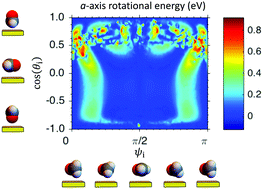An axis-specific rotational rainbow in the direct scatter of formaldehyde from Au(111) and its influence on trapping probability†
Abstract
The conversion of translational to rotational motion often plays a major role in the trapping of small molecules at surfaces, a crucial first step for a wide variety chemical processes that occur at gas–surface interfaces. However, to date most quantum-state resolved surface scattering experiments have been performed on diatomic molecules, and little detailed information is available about how the structure of nonlinear polyatomic molecules influences the mechanisms for energy exchange with surfaces. In the current work, we employ a new rotationally resolved 1 + 1′ resonance-enhanced multiphoton ionization (REMPI) scheme to measure the rotational distribution in formaldehyde molecules directly scattered from the Au(111) surface at incidence kinetic energies in the range 0.3–1.2 eV. The results indicate a pronounced propensity to excite a-axis rotation (twirling) rather than b- or c-axis rotation (tumbling or cartwheeling), and are consistent with a rotational rainbow scattering model. Classical trajectory calculations suggest that the effect arises—to zeroth order—from the three-dimensional shape of the molecule (steric effects). Analysis suggests that the high degree of rotational excitation has a substantial influence on the trapping probability of formaldehyde at incidence translational energies above 0.5 eV.

- This article is part of the themed collection: 2017 PCCP HOT Articles


 Please wait while we load your content...
Please wait while we load your content...